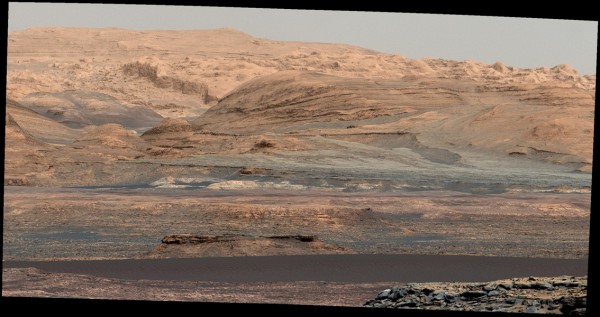Curiosity Rover Now Headed Towards Dark, Active Sand Dunes on Mars
| Ana Verayo | | Nov 19, 2015 06:40 AM EST |
(Photo : NASA/JPL-Caltech/MSSS) For the first time ever, Curiosity rover will explore Mars' active, dark sand dunes.
For the first time ever, NASA's Curiosity rover is headed towards the active, dark sand dunes on Mars, offering unprecedented views for the first time.
Like Us on Facebook
Right now, Curiosity is travelling to the Bagnold Dunes that are located in the northwestern foothills of Mount Sharp. These dark, sandy dunes will be explored and investigated by the rover in the next few days, according to NASA officials.
These are Martian dunes are massive, as Curiosity will study one of them, measuring as wide as one football field and as high as a two story building. Apart from this colossal feature, the dunes are also active, where Martian orbiters reveal evidence of movement, as the dunes travel at three feet every year.
According to Bethany Ehlmann from the California Institute of Technology and NASA's Jet Propulsion Laboratory, this investigation will not only reveal dune activity on Mars but also, provide a better understanding of sandstone layers of the dunes which used to be rocks a long time ago.
Opportunity and Curiosity rovers already explored some sandy swales some time ago however, these are the first active dunes that Curiosity will investigate, featuring slopes where sand are actively sliding down apart from Earth's. The rover will then collect samples using its onboard scientific suite of instruments, where it will scrape some sand using a wheel to compare changes between the surface and subsurface.
According to Nathan Bridges from the Johns Hopkins University's Applied Physics Laboratory in Maryland, these dunes are different from the ones on Earth, as they possess a different texture. Bridges describes that the ripples on the Martian sand dunes are larger than the top of the dunes on Earth, and this has been a mystery. He adds, there are models that are based on lower air pressure and it also requires higher wind speeds to get particles to move.
Curiosity rover has been exploring Mars' massive Gale Crater where it landed there on August 2012. The robotic rover's mission is to determine if Mars can support microbial life where the rover gathered evidence that the Red Planet can, from the Gale Crater's lake and stream system that used to exist in Martian past.
TagsNASA curiosity rover, dark sand dunes mars, curiosity rover dark sand dunes mars, active dark sand dunes mars, NASA, curiosity rover mars, sand dunes mars, rover sand dunes mars, bagnold dunes mars
©2015 Chinatopix All rights reserved. Do not reproduce without permission
EDITOR'S PICKS
-

Did the Trump administration just announce plans for a trade war with ‘hostile’ China and Russia?
-

US Senate passes Taiwan travel bill slammed by China
-

As Yan Sihong’s family grieves, here are other Chinese students who went missing abroad. Some have never been found
-

Beijing blasts Western critics who ‘smear China’ with the term sharp power
-

China Envoy Seeks to Defuse Tensions With U.S. as a Trade War Brews
-

Singapore's Deputy PM Provides Bitcoin Vote of Confidence Amid China's Blanket Bans
-

China warns investors over risks in overseas virtual currency trading
-

Chinese government most trustworthy: survey
-

Kashima Antlers On Course For Back-To-Back Titles
MOST POPULAR
LATEST NEWS
Zhou Yongkang: China's Former Security Chief Sentenced to Life in Prison

China's former Chief of the Ministry of Public Security, Zhou Yongkang, has been given a life sentence after he was found guilty of abusing his office, bribery and deliberately ... Full Article
TRENDING STORY

China Pork Prices Expected to Stabilize As The Supplies Recover

Elephone P9000 Smartphone is now on Sale on Amazon India

There's a Big Chance Cliffhangers Won't Still Be Resolved When Grey's Anatomy Season 13 Returns

Supreme Court Ruled on Samsung vs Apple Dispute for Patent Infringement

Microsoft Surface Pro 5 Rumors and Release Date: What is the Latest?










